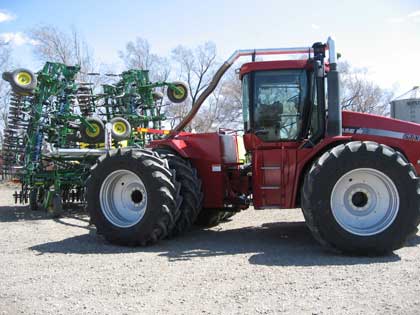Exhaust gases cut fertiliser requirement in Canada

Channelling tractor exhaust gases back into the soil during drilling to provide extra fertiliser may sound like an April Fool’s day story, but it’s exactly what 45 farmers in Canada, the USA and Australia have successfully done in 2007, according to Canadian company N/C Quest.
This Alberta-based organisation, headed by farmer and soil scientist Gary Lewis, claims cooling and channelling exhaust gases such as CO2 back into the ground during sowing via the air flow in pneumatic drills increases soil micro-organism activity by boosting soil carbon content.
“Increasing carbon and thus natural fertility in this way saves some farmers about half their usual fertiliser bill for cereals and oilseeds. It is also helping to reduce emissions of greenhouse gases,” explains Mr Lewis.

Manitoba grower Darrel Carlisle reckons to have cut his fertiliser bill by the equivalent of £136,100 this year.
“We say that about 95% of the exhaust gases of the tractor powering the drill can be captured and applied in this way. Then of course there are the huge savings in gas emissions from the production and transport of the artificial fertiliser that is no longer applied.”
Savings in fertiliser, according to one large-scale grain producer in Canada, are indeed substantial. Darrel Carlisle, who has 2200ha (5400 acres) of combinable crops around the town of Carroll in Manitoba, reckons that he has been able to reduce his fertiliser bill this year by the equivalent of £136,100, halving it compared with conventionally fertilised fields.
Although full yield details were not available at the time of going to press, Mr Carlisle says first signs indicate that yields are at least as good as the long term average with conventional fertilising in Manitoba. Moreover trials in previous years have also seen yields staying level.
 A large cooler fitted to the drill hopper brings exhuast gases down to a safe temperature for injection into the soil.
A large cooler fitted to the drill hopper brings exhuast gases down to a safe temperature for injection into the soil.
Mr Carlisle has also developed his own electrically powered system for more efficient cooling of tractor exhaust gases before they are fed into the drill airflow. He has been testing the effect for three years now and estimates that, drilling at standard revs, he’s putting about 8kg/ha of CO2 into the soil from his tractor engine.
“We’ve been running official tests on soils and plant tissues, including grain, and analysing everything,” comments Mr Carlisle, who adds that no toxins appear to have been found. “The gases and minerals coming out of the smoke-stack is stuff that is naturally in the ground anyway.” The licence and equipment claimed to change exhaust gases into valuable fertiliser costs around £25,000. “But the savings on 600ha of crop could recoup this in a single season,” points out Mr Carlisle.


